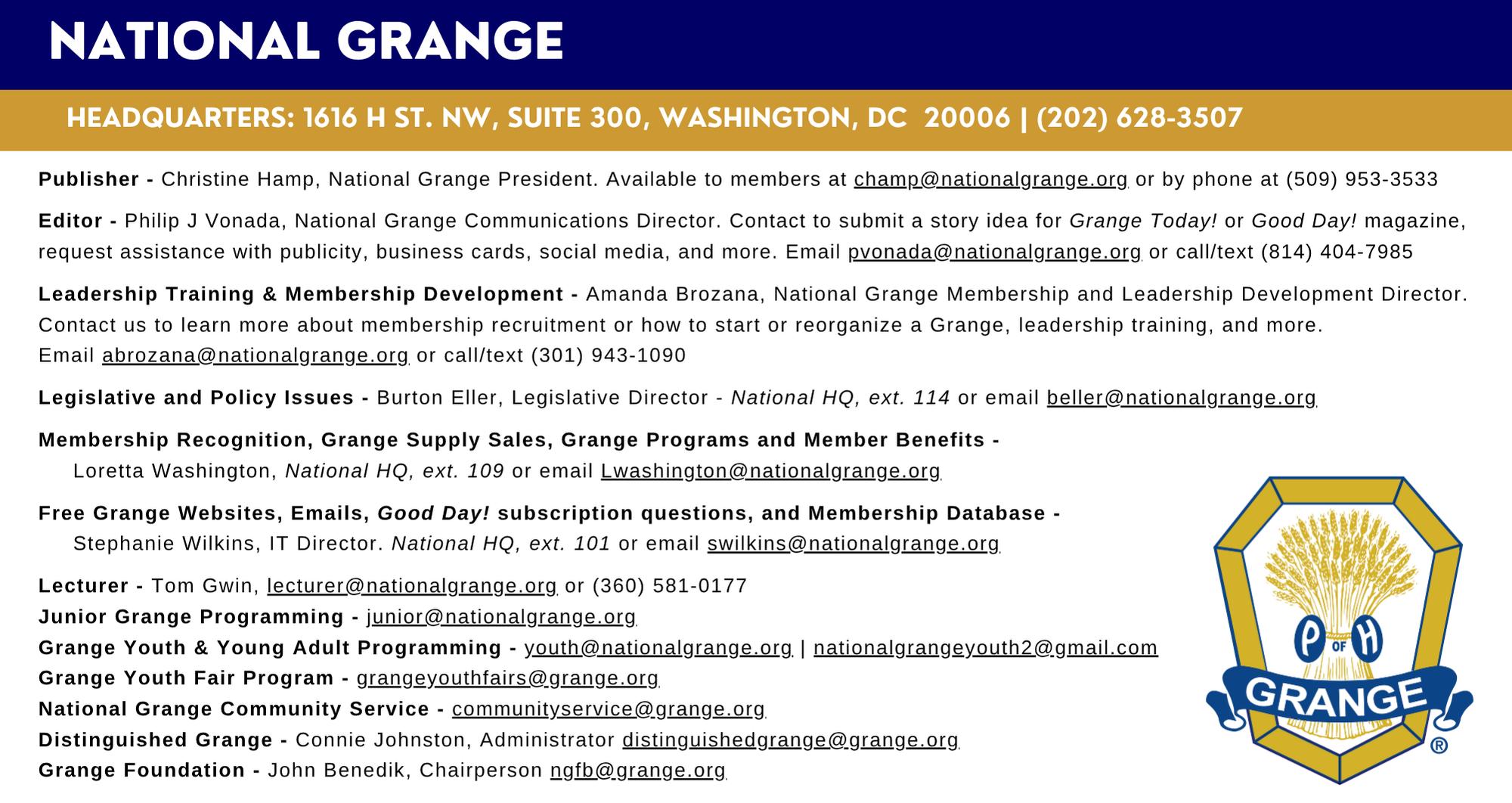

Grange members encouraged to submit nominations as part of America’s 250th
Help ensure rural and Grange voices are included in the nation’s 250th anniversary commemoration
by Amanda Brozana

As the United States prepares to mark its 250th anniversary in 2026, the U.S. Semiquincentennial Commission—known as America250—is gathering stories from everyday Americans to help tell the full and diverse history of our nation. This national effort is calling on individuals and organizations to nominate people from all walks of life to be interviewed and featured as part of the America250 “Storytellers” initiative.
Grange members have long been stewards of their communities and voices for rural America. Now is the time to make sure those voices are included in this once-in-a-generation commemoration. By nominating someone to be interviewed, you help ensure the experiences of rural residents, Grange members, and community champions are part of the permanent historical record being created to celebrate America’s 250th.
Nominees can be anyone who reflects the values, diversity, and resilience of the American spirit—including, but not limited to, longtime Grange members, emerging young leaders, veterans, teachers, first responders, farmers, and small business owners. America250 wants to hear from individuals whose life stories offer insight
In This Issue

Grange members encouraged to submit nominations as part of America’s 250th
into what it means to be American— whether through service, innovation, perseverance, or community impact.
Who Can You Nominate?
• People who have made a positive difference in their communities.
• Individuals from rural areas whose stories are often underrepresented.
• Elders with unique perspectives on history and change.
• Youth leading the way into the future.
• Those whose personal experiences reflect major events or themes in American life.
The process is simple. Visit www.america250.org/nominate to submit your nomination. You’ll be asked to share basic information about the individual and why their story is important to include. Selected nominees may be interviewed, filmed, or profiled as part of the official America250 archives, programs, or media features.
This is not a National Grange-led project, but we encourage every Granger to take part in this national effort. We have a powerful opportunity to lift up the stories of our members, neighbors, and communities—people who might not seek the spotlight, but whose lives reflect the enduring spirit of America.
Let’s make sure the voices of rural America are heard. Nominate someone today and help shape the story of our shared past and future.

Opinion - Farms in Crisis: Fixing the Broken Labor System
by Annie Johnson
National Grange Intern Agriculture major, Buena Vista University
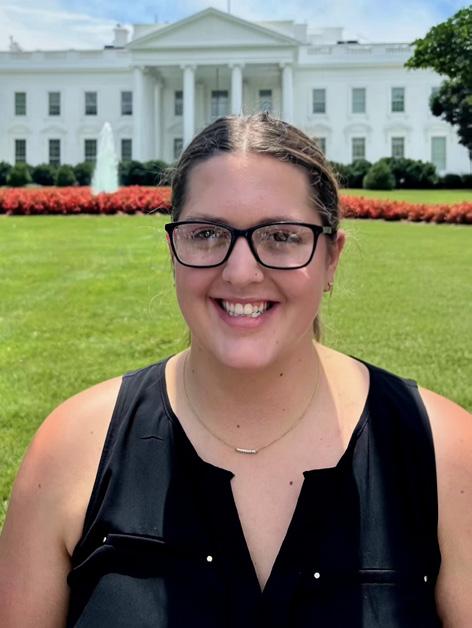
Waves of immigrants have come to the United States in search of a new beginning. Some fled religious persecution, others sought economic opportunity, or hoped to escape troubled pasts. Many established in urban areas like New York City, while others moved to rural regions to work in agriculture, laying the foundation for today’s migrant workforce. Out of the 2.5 million farmworkers within the U.S about 90% are undocumented, according to the National Center for Farmworker Health. This migrant labor force has become an indispensable part of American agriculture, especially in labor-intensive sectors.
In 1964, the United States government terminated the Bracero Program, a bilateral agreement with Mexico that allowed Mexican citizens to enter the United States as short-term workers, primarily in agriculture and the railroad industry. Initiated during World War II and extended through the Korean War, the program operated from 1942 to 1964, bringing in 4.6 million Mexican workers into the country. While the program provided critical labor to American farms, it also drew criticism over declining housing conditions, poor transportation, and exploitative working environments, which ultimately led to its termination. Now, farmers and ranchers all around the country are asking why a Bracero-type program shouldn’t be considered today.
Out of the current 2.5 million migrant workers, about 60% of them come from Mexico . When the COVID-19 pandemic hit in 2020, most of the country shut down, but agriculture kept going. The industry had to continue operating, supplying the nation and
the world. With an estimated 5.8% of Americans unemployed and a domestic workforce unwilling or unqualified to fill agricultural jobs, farmers increasingly turned to migrant labor. Primarily from Mexico, either through the country illegally or overstay their visas to meet labor demands.
President Trump has recognized the need for these foreign workers, despite his big mass deportation plan, he has opened the door to agricultural labor policies. In April, he suggested that a new program would be set up to help legalize farmworkers and reduce the risk of mass deportation. Iowa Governor Kim Reynolds has contacted the White House to be involved in discussions on how to keep migrant agricultural workers in the country. She states, “actually continue to highlight how important it is so that we get this right ”
Labor implemented the H-2A visa program, a temporary agricultural visa system that permits foreign nationals to work in the U.S on a seasonal or temporary basis. By 2023, the H-2A program was awarding 310,000 visas annually, a 58% increase over 2018. The USDA refers to temporary work as “work that lasts no longer than 1 year, ” While seasonal work is defined as “work that needs more help than usual because the work is tied to a certain time of year by an event or pattern, like a short annual growing cycle.
Despite its importance and efficacy, the H-2A program remains deeply flawed. Arizona farmer John Boelts, quoted in a Progressive Farmer article titled “Guest Workers, Red Tape and a Broken System, “calls the program “expensive, complicated and out of step with modern farm needs. ” Regulations requiring employer-provided housing, even when workers commute daily, raise costs and create inefficiencies.
Not every operation needs nor can afford a large migrant workforce. States like California, Texas, Washington, Oregon, Oklahoma, and Wyoming rely heavily on these workers to keep
continued on page 6

Final Call: Rural Life Initiative Grant applications due on July 31
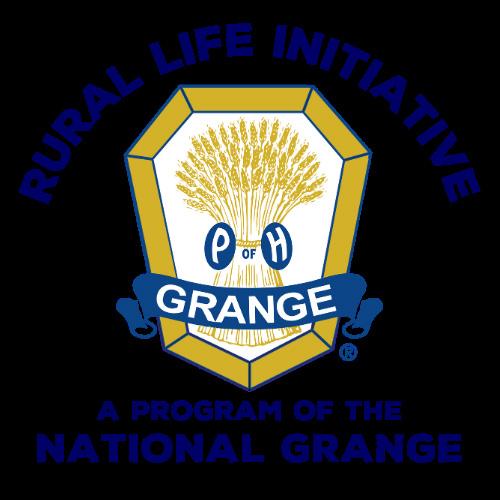
On June 24, the Rural Life Initiative (RLI) officially launched nationwide, with Granges having the opportunity to apply for one of 32 available grants.
The RLI supports creative, communitydriven projects that improve life in rural and small-town America. Whether your Grange wants to host a health and wellness fair, run a youth leadership camp, preserve a local agricultural tradition, or start a program that builds resilience in your area, this grant can help bring your vision to life.
Grants available include:
• Thirty (30) $1,000 grants for projects that can be completed and reported on by September 30
• Two (2) $5,000 grants for projects that can be completed and reported on by December 31
State and Community/Subordinate Granges of all shapes and sizes are welcome to apply for these grants, as long as they meet the following criteria:
• You must include at least one partner organization beyond your Grange.
• You must submit a current membership list with the application proposal.
• You have the flexibility to choose topics based on local needs, but:
• Projects cannot involve building improvements or equipment purchases.
• Projects must focus on recruiting and engaging new members.
• Projects must connect to at least one Project Sustenance pillar (Food Security, Community and personal resilience, Self-sustainability). Tip: Watch the Introducing Project Sustenance webinar for more information on these topics.
“We are excited to see what Granges will create for their communities,” said National Grange President Christine Hamp. “The flexibility of this grant cycle encourages Granges to truly think outside of the box and the Grange ‘norms.’ I look forward to seeing the dynamic events and powerful programs that this grant helps make possible.”
All applications - for both the $1,000 and $5,000 grant - are due by July 31. Even if you’re still finalizing details, don’t wait! A well-developed idea and a committed team are the foundation. The application is straightforward, and support is available from National Grange staff if you have questions or need guidance.
Let’s work together to build stronger, more resilient rural communities. We encourage all Granges—large or small, urban or rural—to apply and make a lasting impact.
More information about the RLI, links to the webinars, and the application are all available at https://www.nationalgrange. org/rural-life-initiative. If you have questions, please contact rurallifeinitiative@grange.org
Don’t miss your chance—submit your application today!
COVID-19 Doesn’t Take a Summer Vacation—
But
It Can Ruin Yours

Summer is finally here—and so are the long-awaited beach days, barbecues, road trips, and outdoor adventures. But nothing spoils summer fun faster than getting sick. COVID-19 may feel like a winter concern, but it doesn’t take a break. Surges can happen at any time of year, including now.
For adults 50+, the risks are even higher. COVID-19 can disrupt your plans, seriously impact your health, and leave a lasting toll. You can protect yourself by staying up to date on COVID-19 vaccination, helping reduce your risk of
severe illness and doing what you can to keep your summer plans on track.
If you are 50 or older and have not received a 2024-2025 COVID-19 vaccine, it is not too late. You can still receive the latest dose of the COVID-19 vaccine to stay protected against severe respiratory illness this summer and into the fall.
Visit cveep.org/stayupdated to learn about the importance of staying up to date with COVID-19 vaccines and how to stay protected all year long.

National Grange Policy Updates & Issue News
July 2025
Agriculture and Food
Farm bill
Many farm bill provisions were included in the budget reconciliation bill that the President signed into law on July 4. See “What’s in the One Big Beautiful Bill Act for Farmers and Ranchers” in this newsletter.
“Skinny” farm bill is next
Although several major sections of the farm bill were included in the One Big Beautiful Bill Act (OBBBA), many key policies haven’t been updated since the last farm bill was passed in 2018. These include reauthorization of the Conservation Reserve program, USDA direct and guaranteed loans, rural development grants, industrial hemp, and more. At this time, it is uncertain when Congress will address the remaining farm bill provisions. Many farm bill veterans are concerned that the traditional bipartisan farm bill coalition on the Hill may have been damaged by the cuts to the Supplemental Nutrition Assistance Program (SNAP) contained in the OBBBA.
Surveillance of foreign ownership
Agriculture Secretary Brooke Rollins has released the USDA’s National Farm Security Action Plan to track foreign adversaries’ ownership of agricultural land, agricultural transportation, agricultural storage, and agricultural processing. A webpage will track which countries own land and agriculture-related assets by U.S. county. It will have a new reporting portal to receive and review claims of adversarial foreign influence with respect to the purchase of farmland and business dealings in other facets of the U.S. agricultural supply chain.
Healthcare
Medicaid cuts will affect rural health care
The One Big Beautiful Bill Act (OBBBA), signed into law on July 4, contained approximately $1 trillion in cuts over the next decade to the Medicaid program. Rural hospitals and clinics are critical access facilities that treat large percentages of uninsured and underinsured patients. These rural facilities largely depend upon the Medicaid program to cover the costs that patients cannot pay in order to keep the hospital’s doors open. The National Grange partnered with healthcare providers in a high-profile campaign to raise awareness in Congress of the impact such massive cuts would have on the future of rural health. As a result, Congress included a $50 billion, five-year Rural Health Transformation Program in the OBBBA. The fund is to be allocated to the states to implement rural health-related activities. States must use these funds to promote evidencebased interventions, payments to health care providers, promote technology-driven solutions, provide recruiting and retraining for clinical staff, support access to behavioral health, launch local and regional partnerships, develop strategies that produce long-term financial solvency, and more. The Grange’s rural health partners will have to wait and see if this transformation program can make a real difference toward keeping the doors of rural hospitals open.
Immigration/Ag Workforce
Agriculture needs a legal migrant workforce
The current focus on the deportation of undocumented immigrants has elevated awareness of the dependency of U.S.
Perspectives
“He that never labors may know the pains of idleness but not the pleasures.”
- Samuel Johnson, English author
“The dignity of labor depends upon not what you do, but how you do it.”
- Edwin Osgood Grover, American publisher and educator
“When you put on your clothes, remember the weaver’s labor; when you take your daily food, remember the husbandman’s work.”
- Chinese proverb
“Labor disgraces no man; unfortunately, you occasionally find men who disgrace labor.”
- Ulysses S. Grant, 18th President of the United States (1869-1877)
“We have neglected the truth that a good farmer is a craftsman of the highest order; a kind of artist.”
- Wendell Berry, American author
agriculture on immigrant farm labor. It’s been over three decades since Congress passed major immigration reform legislation. The time may be right to begin that debate again. See “Opinion - Farms in Crisis: Fixing the Broken Labor System” by National Grange summer intern Annie Johnson in this newsletter.
Taxes
Tax relief extended and many provisions made permanent
The budget reconciliation package passed by Congress and signed into law by the President extended the 2017 tax cuts that were due to expire at the end of this year. Many of the provisions were made permanent in the IRS tax code. Most of these cuts mirrored National Grange policy. See “What’s in the One Big Beautiful Bill Act for Farmers and Ranchers” in this newsletter.
Transportation
Expand Highway Trust Fund contributions
Investments in roads, bridges, and other rural infrastructure are critical to America’s agricultural industry and rural residents. However, the HTF is facing challenges that could lead to
insolvency within a few years. Gas-powered vehicles support the HTF through gas taxes. However, electric and hybrid vehicles do not pay into the HTF based on the electricity they use. Grange policy is that all vehicles, regardless of fuel type or technology, should contribute to the upkeep and improvement of transportation infrastructure. The National Grange joined 26 agriculture groups in asking Congress to ensure that all vehicles pay into HTF. As a result, the budget reconciliation package/ One Big Beautiful Bill Act, signed into law, contains provisions for electric and hybrid vehicles to pay annual fees into the HTF.
View From the Hill is written and compiled by Burton Eller National Grange Legislative Director beller@nationalgrange.org
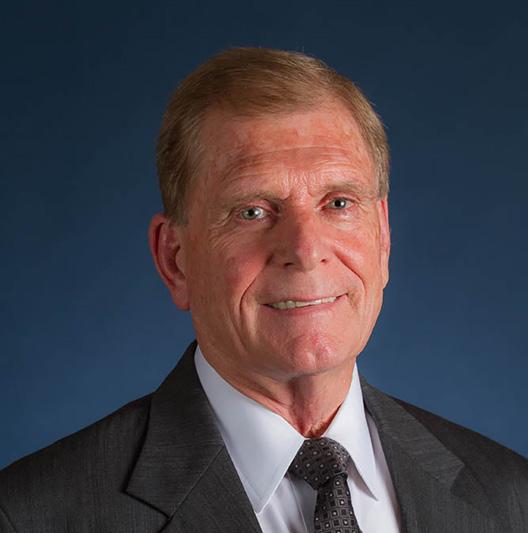
What’s in the One Big Beautiful Bill Act for Farmers and Ranchers?
by Burton Eller National Grange Legislative Director
Farm Bill Provisions
Farm programs covered by the 2018 farm bill addressed the needs of farmers and ranchers when it was passed. However, seven years and two farm bill extensions later, farm programs need to be updated. With rising costs and falling farm income, many producers are unable to utilize the current tools and safety nets crafted to protect them in the previous farm bill. In order to move expeditiously on the most pressing farm program updates, Congress decided to include parts of the farm bill through a legislative process known as budget reconciliation, which allows for expedited consideration of budget-related policy.
After long debate and razor-thin votes in the House and Senate, Congress delivered the One Big Beautiful Bill Act (OBBBA) to the President, who signed it into law on July 4. So, what does the 870-page Act do for farmers and ranchers? It provides $65.69 billion in new funding for the farm bill. It also sets a new precedent for agriculture policy by paying for increased spending on farm programs by cutting nutrition assistance. This strategy also splits the farm bill into two parts: one that has just been passed and another that contains the remaining sections of the farm bill that Congress will need to address later.
Commodity Programs
The largest share of new farm bill funds, $53.1 billion, goes to commodity programs. The bill is expected to sharply increase payments through the Price Loss Coverage and Agriculture Risk Coverage programs. The Price Loss Coverage program triggers payments on the base acreage of a commodity when
market prices for the commodity fall below reference prices. The Agriculture Risk Coverage program offers payments based on county revenue and is particularly popular among corn and soybean growers.
The Act will also reduce crop insurance premiums that farmers and ranchers pay to protect the commodities they grow..
Dairy
The Act will increase the Dairy Margin Coverage program’s tier I and tier II coverage from the first 5 million pounds of milk to the first 6 million pounds.
Sugar
Sugar growers will benefit from increased loan rates and storage rates.
Biofuels
The 45Z clean fuels credit will be extended to 2029, but the credit value for sustainable aviation fuel will be cut from $1.75 a gallon to $1.00. The 40A credit for biodiesel plants that produce less than 60 million gallons a year will be extended and increased.
Additional farm programs
Several more farm programs were included in the OBBBA. In descending order of their funding levels, these are crop insurance, disaster assistance, trade, research, horticulture and energy.
Supplemental Nutrition Assistance Program (SNAP)
Cuts to SNAP to fund farm programs created a highly contentious debate as the legislative package moved through
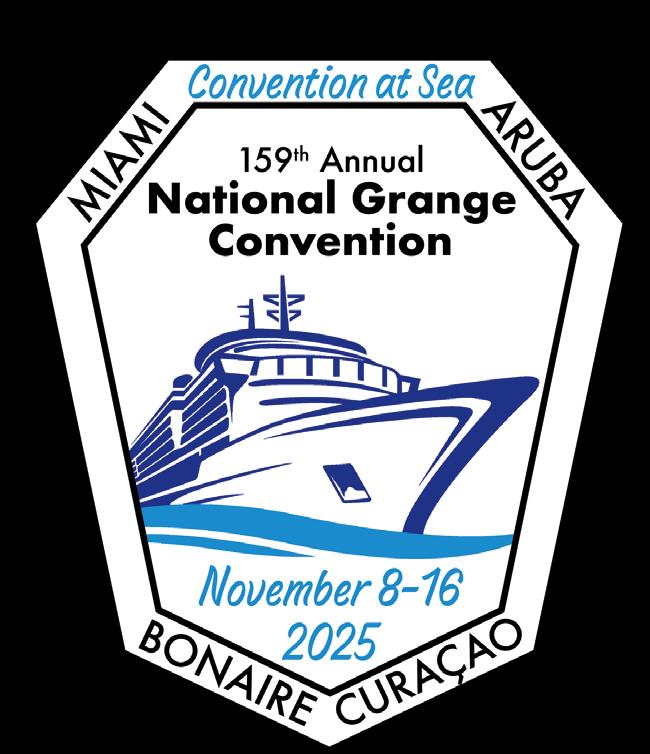
Have you registered? 159 Annual National Grange Convention th November 8-16, 2025
The 159 Annual National Grange Convention will be here before you know it! th
Sailing from Miami to the Caribbean islands of Aruba, Bonaire, and Curacao, this one-of-a-kind convention blends business with fun, fellowship with learning, and so much more.
Whether you're a longtime Granger or a friend or family member, this unique setting offers unforgettable opportunities to connect, grow, and be inspired. With engaging workshops, meaningful meeting times, and moments of celebration - not to mention everything Carnival has to offer - there’s something for everyone on board. You’ll leave energized with fresh ideas, lasting friendships, and a deeper connection to our mission. Don’t miss your chance to be part of Grange history on the high seas!
Updates are being posted regularly on social media and on the main information page. So visit today to be sure you’re registered.
Visit: https://www.nationalgrange.org/159ngconvention today!
Reserving your cabin does not register you for the convention. Make sure to do both!
Date
Saturday, November 8
Sunday, November 9
Monday, November 10
Tuesday, November 11
Wednesday, November 12
Thursday, November 13
Friday, November 14
Saturday, November 15
Sunday, November 16
Some National Grange Events*
Saturday, November 8
Registration of all attendees
Sail-Away Party
Sunday, November 9
Opening of Session
President’s Addresses
Tuesday, November 11
Assembly of Demeter Business Meeting
Wednesday, November 12
Conferral of the Seventh Degree & Assembly Convocation
Friday, November 14
Election of Officers
Saturday, November 15
Opening of Session by Youth Officers
Installation of Officers
*registration required

THIS COULD BE YOU!

HOW TO ENTER
You could be one of the special guests chosen to represent a National Grange of ficer during the closing of the second day ’s business of the 159 Annual Convention on Monday, Nov. 10 at 4 p.m.!
Make a $25 donation to the Grange Foundation General Fund between June 21 to Nov. 2, 2025, and you will have the opportunity to receive a priceless experience serving as a National Grange Officer during the closing ceremony.
9 donors will be drawn. (Each individual $25 donation counts as a separate opportunity for the drawing).
You (or someone you choose) must be present at Convention aboard the Carnival Horizon to take part
Winners will be notified on Monday, Nov 3 and have until Thursday, Nov 6 to accept or notif y the National Grange of their stand-in selection.
If you are assigned a speaking or active role, you should be prepared to perform the duties either from memory or using the manual .
Why are there not 17 being chosen?
National Grange President Christine Hamp offered the National Officers the first opportunity to donate $100 and give their sash to somebody of their choosing!
The following officers claimed their sashes for mentors, friends and loved ones: President , Vice President , Lecturer, Assistant Steward, Lady Assistant Steward, Secretary, Gatekeeper, Ceres
The following offices will be chosen from new donors: Steward, Chaplain, Treasurer, Pomona , Flora , and four Executive Committee members.

large–scale production running. But small producers in states such as Wisconsin and Vermont often lack the resources to participate in programs like H-2A. The application process is complex and costly, leaving these smaller operations without the labor they desperately need. Familyrun farms, though small, play a crucial role in sustaining the regional food system and deserve better policy support.
In addition to H-2A, E-Verify systems were created under the Illegal Immigration Reform and Immigrant Responsibility Act (IIRIRA) of 1996. This program enables employers to confirm worker eligibility. While it aims to ensure compliance with immigration laws, the system is burdened by costly requirements and ongoing issues in hiring and retaining workers.
Another potential solution is the TN visa, created under the 1994 NAFTA agreement, now known as the United States-Mexico-Canada Agreement (USMCA). It allows highly skilled Mexican and Canadian professionals to work in the U.S, fields such as veterinarians, animal scientists, animal breeders, dairy scientists, soil scientists, plant breeders and many high-skill professions within agriculture . The TN visa offers benefits such as indefinite renewal, exemption from labor certification, and the ability
continued from page 2
to bring dependents. However, it only applies to professionals and does not address the general farm labor shortages most growers face. The pork industry has utilized the TN visa in bringing specialists like veterinarians, animal scientists and animal breeders to help fill the empty labor jobs.
To address systemic issues in agricultural labor policy, Congress reintroduced the Farm Workforce Modernization Act in 2025. The bill proposes reforms to the H-2A program by simplifying the application process, improving housing requirements and providing more flexibility for employers with year-round labor needs. Most importantly it establishes a path for undocumented agricultural workers to earn legal status through continued employment in the U.S agriculture sector.
Representative Zoe Lofgren (CA-18), co-sponsor of the bill with Representative Dan Newhouse (WA-4), emphasized, “The men and women who work America’s farms feed the nation. However, in the past few years, we’ve seen labor shortages contribute to high food prices. It is essential we provide stability to this critical workforce. ”
A more realistic solution will require reforming and modernizing the H-2 to meet today’s needs, both for immigrant
families and for the farmers who rely on the workforce. This includes streamlining the application process, updating housing and transportation mandates, and extending the duration of the visas. The USDA must listen directly to farmers and adjust policies to reflect the realities of 21st-century agriculture.
Despite the bureaucratic challenges, most farmers deeply value foreign labor–not only for its necessity in performing manual labor but also for the skills, cultural knowledge, and innovations that migrant workers contribute. In return, many workers gain wages, housing, and experience they can take home with them. Migrant labor is not just a necessity–it is a key pillar of American agriculture, a sector that contributes $1.537 trillion, or 5.5%, to the nation’s GDP .
The future of American agriculture depends on its ability to attract, protect, and integrate migrant labor. The National Grange believes that there can be a simple, fast process for these farms to get the help they need. Through thoughtful reform–centered on fairness, flexibility, and practicality–the U.S can better support both its farmers and the millions of workers who sustain the nation’s food supply.
Support Grange Youth and Juniors with a Custom Cruise Door Hanger!
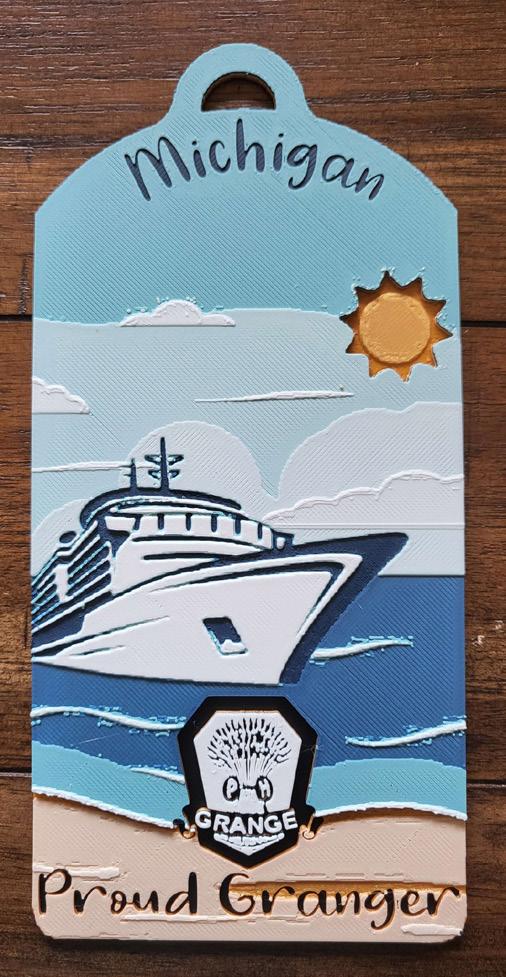
Grangers heading to the 2025 National Grange Convention at sea—or anyone who wants to show their Grange pride—can now preorder a custom 3D-printed door hanger to benefit the National Grange Foundation for Youth and Juniors!
These $10 door hangers are designed with a magnetic back for cruise ship doors and include a hook for display after the cruise. Each one proudly displays your Grange affiliation and state, perfect for sparking conversation and showing off your Granger spirit during this
year’s convention aboard the Carnival Horizon. Items are designed and created by Grange member Eugene Fletcher (MI), who operates his own 3D-print company, and has become known for his fidget toys at previous conventions. Preorders are open through September 15 and can be picked up with your convention registration or shipped to your home if you’re not attending.
Ordering details:
• Cruise attendees: Use promo code GRANGE2025 at checkout to waive the $5 shipping fee.
• Not cruising? Leave the promo code blank and your order will be shipped directly to you.
• Multiple states? Just add one item per state to your cart. Place your order today at: https://www.3dgenedesigns.com/ product-page/national-grange-door-decoration Questions? Reach out to 3dgenedesigns@gmail.com. All proceeds support Grange Youth and Junior programming, while showing off your Grange pride.
One Big Beautiful Act...
Congress. In addition to addressing waste, fraud, and abuse in the program, states will be required to cover a portion of SNAP benefits for the first time. The full extent of the cost-share is determined by the state SNAP error rate. The cost-share would not be imposed on states with error rates below 6%. Cost-share for states with the highest error rates would be delayed for two years to give them the chance to correct their error rates. State administrative cost-share will increase from 50% to 75%. Work requirements will be imposed on able-bodied parents of children ages 14 and older. The current SNAP age requirement is 18. The bill retains a ban on immigrants receiving SNAP benefits unless they are citizens or have permanent residency.
Tax Provisions
The bill expands business expensing allowances and permanently extends key benefits of the 2017 Tax Cuts and Jobs Act that were set to expire at the end of this year. The tax package includes multiple provisions that benefit farmers, ranchers, forest landowners, and other agricultural businesses.
Estate tax relief
Exemption levels are increased to $15 million per individual, indexed to inflation, and made permanent. The stepped-up basis is preserved to prevent unnecessary capital gains tax on estates.
Section 199A qualified business income deduction
The Section 199A deduction helps agricultural producers and farmer cooperatives compete on a level playing field with larger corporations by allowing them to deduct 20% of their qualified business income. This provision is made permanent.
Lower individual tax rates and expanded tax brackets made permanent
Reduced tax rates and broader tax brackets are essential for farmers and ranchers, enabling them to keep more of their earnings to reinvest in their businesses and manage increased production costs.
Section 179 expensing increased
continued from page 5
Increasing the Section 179 expense limitations from $1 million to $2.5 million will be helpful to producers making capital investments. Section 179 is part of the U.S. tax code that allows farms and small businesses to deduct the full cost of equipment, vehicles, and certain buildings in the year they’re purchased and put into use, rather than writing them off slowly over several years through depreciation.
Bonus depreciation is restored
Restoring 100% bonus depreciation permanently will significantly benefit farmers and ranchers by enabling investments in equipment and infrastructure without waiting for delayed tax benefits.
Non-Agriculture Provisions
Additional program cuts of note
The OBBB cuts the Medicaid program funding by $1 trillion. Estimates suggest that rural areas will see a reduction of $155 billion in federal funding over the next 10 years. Rural hospitals and clinics are especially concerned because they are already operating in thin margins. Rural medical facilities are critical access providers, which means they serve large populations of uninsured and underinsured rural residents and rely on Medicaid funding to cover patient costs. The legislation creates a new fiveyear $50 billion Rural Health Transformation Program for states to develop a detailed plan for bolstering rural hospitals and improving rural health outcomes.
Additional spending of note
An investment of $350 billion will be used for national security, deportation of illegal immigrants, and to create a “Golden Dome” defensive system over the United States.

Hamp Watch: Where is our National Grange President this month?
This monthly feature highlights where National Grange President Christ Hamp has been and what she’s been up to in the month prior. Want to see her in your neighborhood or at your Grange event? Email her at champ@nationalgrange.org.
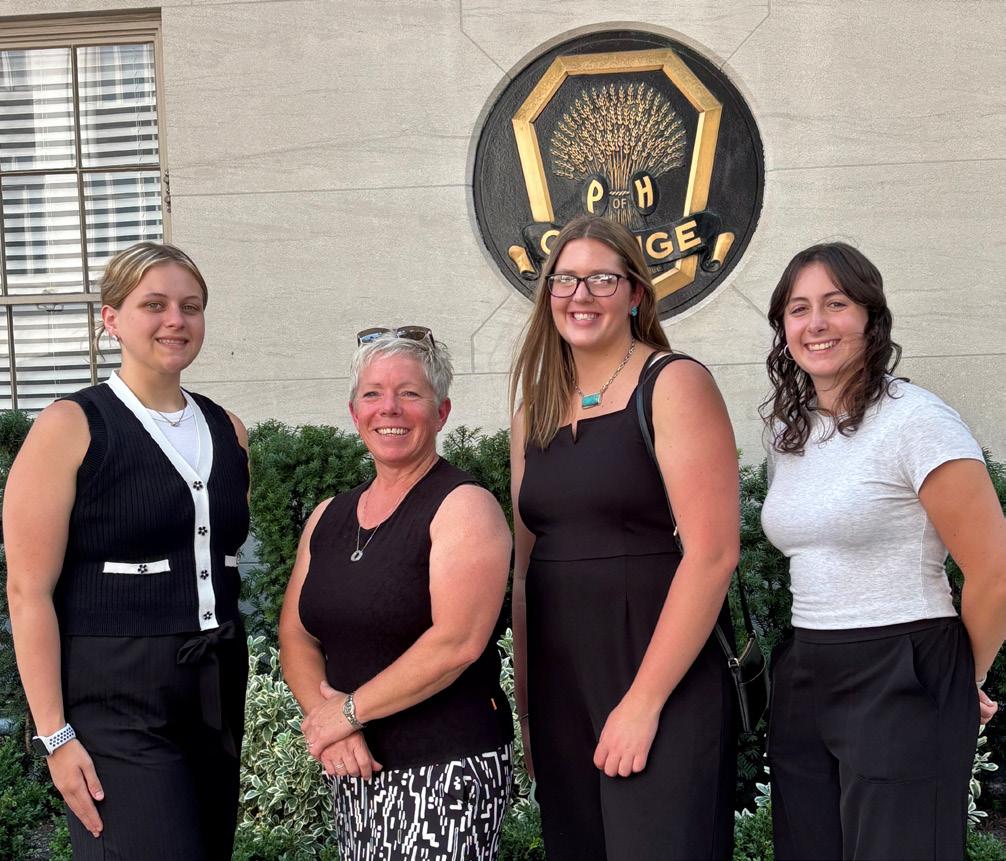
July 3: A photo op with our three summer interns outside the National Grange Headquarters in Washington, D.C. on the same day they filmed my first TikTok video.
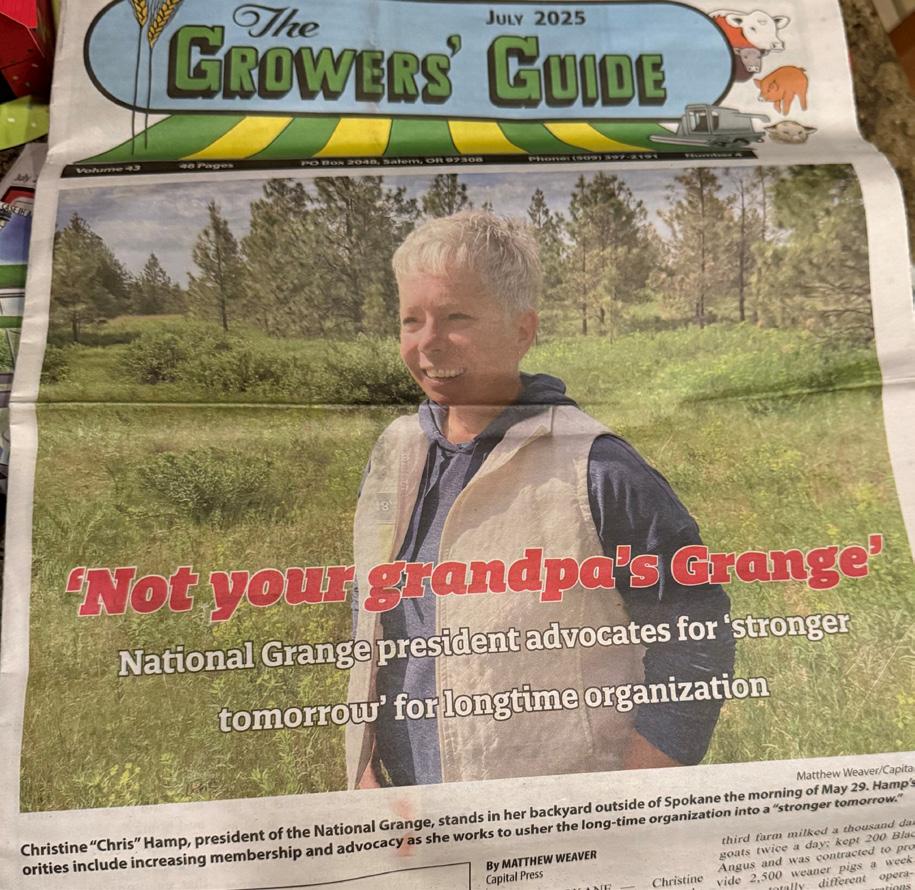
July 12: Both the Capital Press and the Growers’ Guide featured a recent interview detailing my vision for the future of the Grange. (Read the interview in the July 11 issue of Grange Today!.)
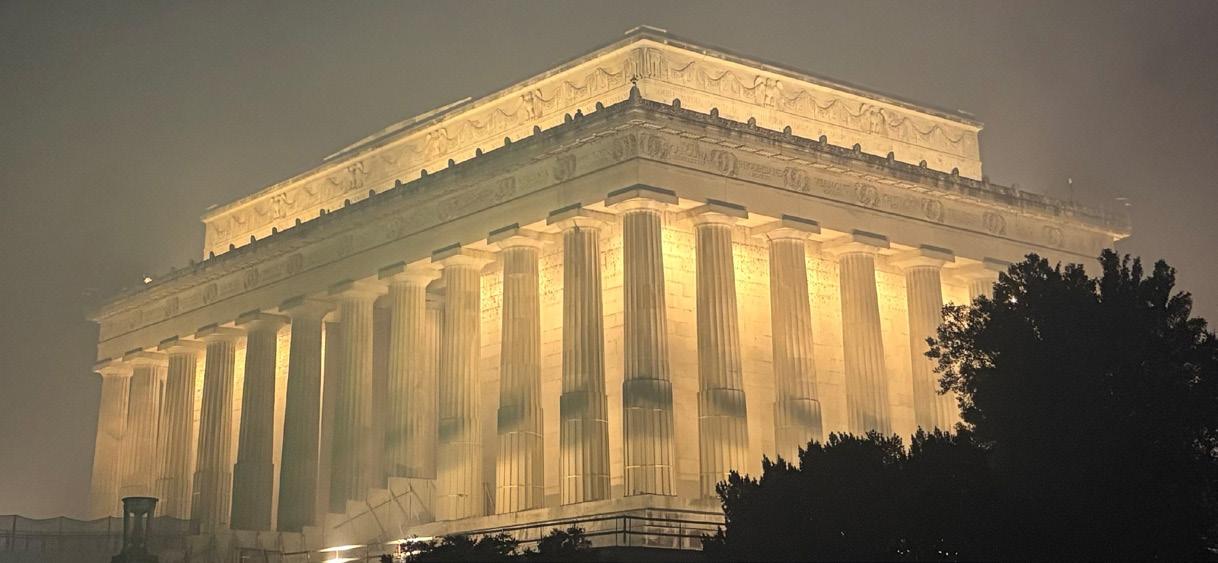
July 4: Duane and I were thrilled to be in Washington, D.C. for the 249th anniversary of America; to witness a reenactment of the reading of the Declaration of Independence, to watch the patriotic parade down Constitution Avenue, and especially, as evening fell, being present as the sky above the National Mall erupted in a spectacular fireworks display. A powerful reminder of the freedoms we cherish and the communities we serve.

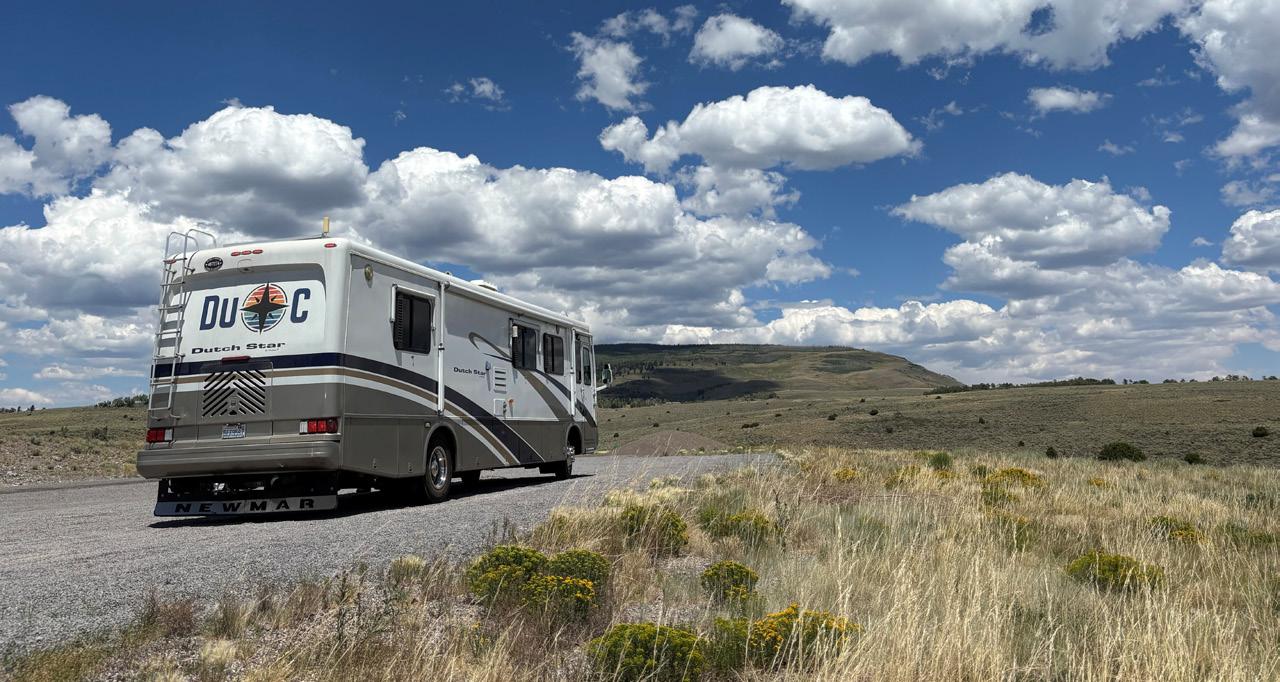
July 17: On the road to Grange Revival. Our RV became my
office on wheels – a personal chauffeur, a hot spot, a laptop, and away we go! Mom followed us in her own little RV, sharing laughter, stories, and miles of scenic beauty.

The America’s 250th Grange Workgroup is celebrating our country’s 250th Anniversary by “throwing back” to some classic recipes from Grange cookbooks. Do you have favorite recipes that evoke the American spirit which you would like to see published again? Send them to Lew Gaskill at olgaskill@comcast.net. Please include which Grange cookbook your recipes come from.
Shoofly pie's origins can be traced back to the 1870s, evolving from a "Centennial Cake" created for the 1876 U.S. Centennial celebration in Philadelphia. It's believed to have been a way to use leftover ingredients and became popular due to its long shelf life and simple recipe. Historians say the pie gained popularity after the Civil War, with the introduction of baking powder by Pennsylvania Dutch bakers.
ShooFly Pie
3/4 cup baking molasses
3/4 cup boiling water
1 teaspoon baking soda
1 1/2 cups flour
Recipe courtesy of Florence E. Williamson, Bottle Run Grange, Pennsylvania from “What’s Cookin’ in the Grange,” National Grange Cookbook, 2000
Yield: 6-8 servings
2/3 cup sugar
1/2 teaspoon cinnamon
1/4 teaspoon ginger
1/4 teaspoon salt
Combine the molasses, boiling water and baking soda in a bowl and mix well. Let stand until cool. Combine the flour, sugar, cinnamon, ginger, salt and cloves in a bowl and mix well. Cut in the butter with a pastry blender until crumbly. Spoon 1/4 of the crumb mixture into the pie shell. Spread with the molasses mixture. Top with the remaining crumb mixture. Bake at 350 degrees for 40 minutes. Cool to room temperature.
1/8 teaspoon ground cloves
1/3 cup butter
1 unbaked (10-inch) deep-dish

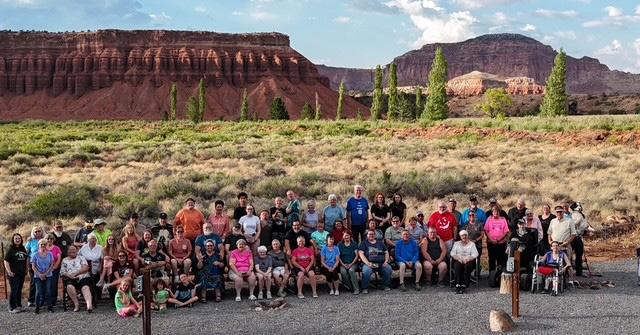
July 21: Grange Revival - Torrey, UT
Above: 70 Grangers, family, and friends traveled over 110,000 miles to attend the 4th edition of Grange Revival, fondly known as “Grange with your Feet Up,” under the open skies of Torrey, Utah. This unique week-long gathering offers adventure and opportunities to create cherished memories and meaningful moments that will last a lifetime.
Right: The Grange Revival Planning Team consists of Janet and Tony Fishovitz (PA), Karie Blasingame (IL), Jody and Jodi Ann Cameron (CT), Amanda Brozana (WA), and Chris and Duane Hamp (WA).
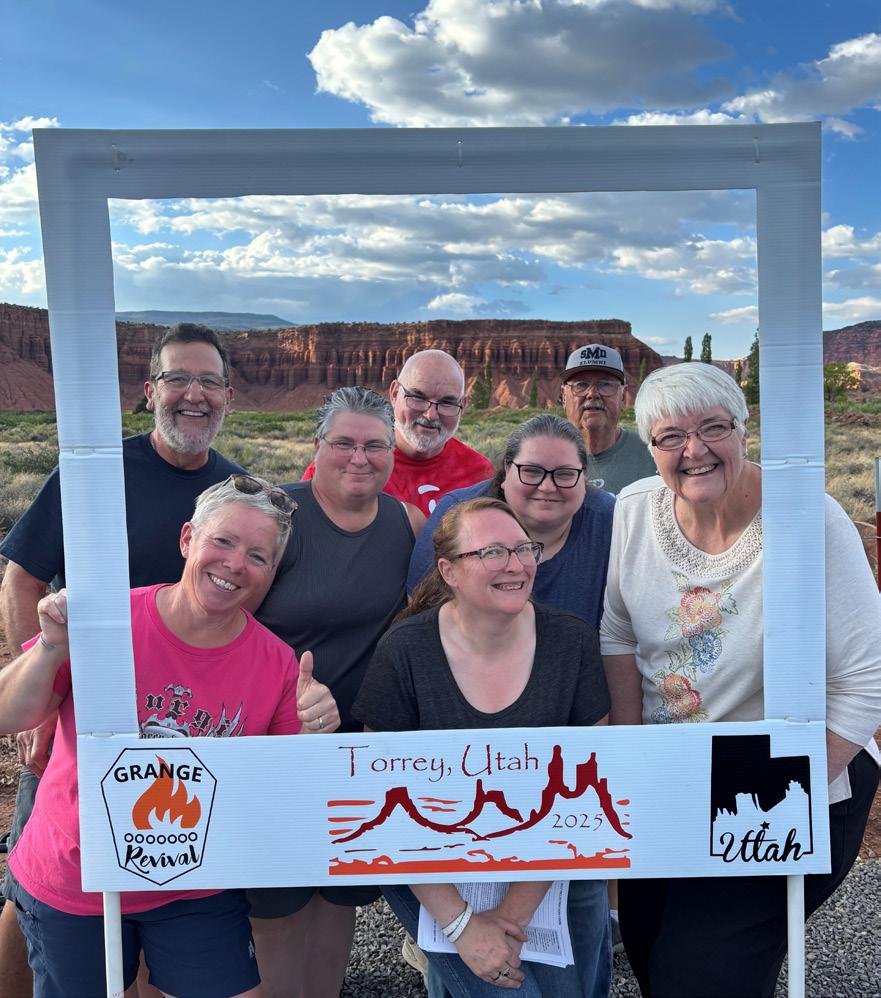
Grange Benefit:

Helping you find the best solution for your hearing needs and lifestyle – at the best value. Grange Members and their families receive:
• Discounts up to 48% on today’s latest technology, including hearing aids and tinnitus options
• FREE annual hearing consultations
• Access to a nationwide network of 3,000+ hearing professionals
• Three-year supply of FREE batteries (40 cells per hearing aid purchased per year)
• One year of free office visits (limit of six)
• 60-day risk-free trial period
• FREE Deluxe Warranty Plan, including loss and damage
• Financing plans available (subject to credit approval)
With Start Hearing, their Hearing Care Advisors are with you each step of the way. To find out more and to schedule your hearing consultation, please call (833) 926-2824 or visit www.starthearing.com/partners/grange

